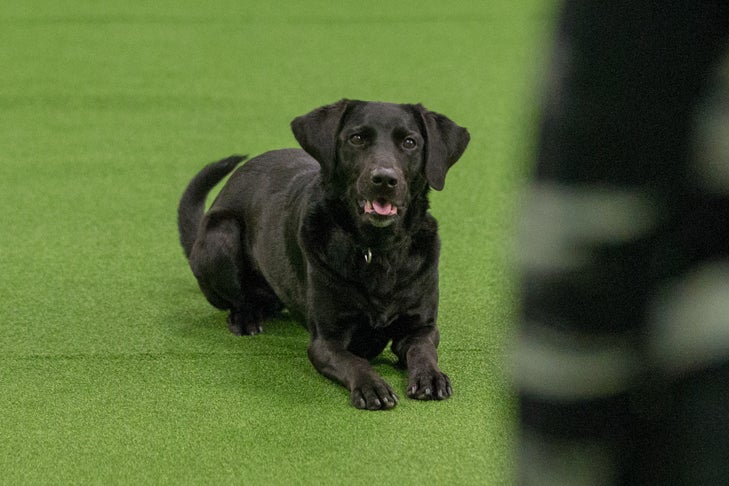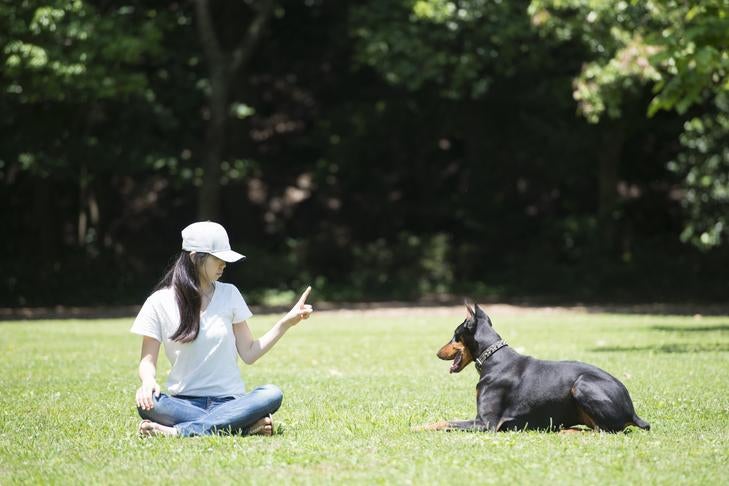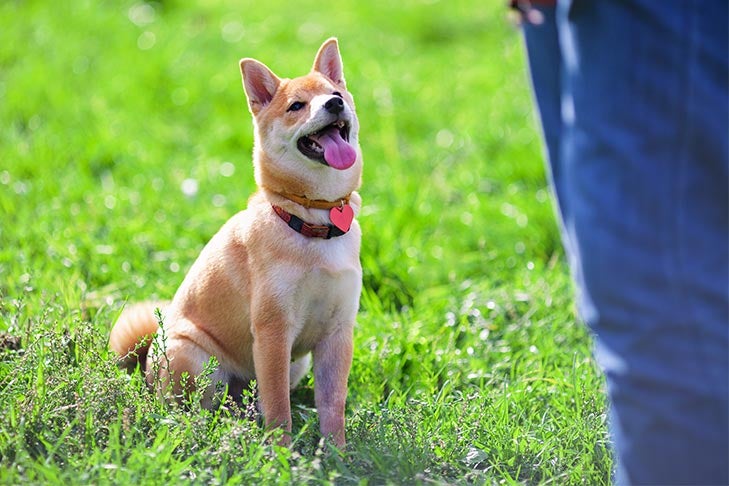
No doubt you’ve seen dogs in competition events like Rally or Obedience staying perfectly still no matter what is going on around the ring. But a solid “Stay” isn’t just important for dog sports, it’s helpful for good manners and household obedience as well. If your dog can hold a position like sit or down until you release them, it makes so many things easier such as grooming, answering the door, or carrying in a load of groceries. But many dog owners struggle to get their dog to stay. If you take your time and follow these steps, your dog will be staying put like a champion.
Stay Until You’re Released
Unlike the cue “Wait” which means hold on for a moment, “Stay” means stay in a specific position until I release you. Technically, if you ask your dog to stay while you go out to get the mail, even if you’re gone for an hour chatting with the neighbor, your dog should still be in the exact same spot when you return.
But what does it mean to release your dog? A release cue is a word you use to tell your dog they are free to move. It’s used to end a behavior. In fact, you can use a release word with any behavior. For example, you can teach your dog to sit or lie down until they are released, in effect building an automatic stay into the position. But however you choose to use your release word, use it consistently and exclusively to let your dog know the behavior is done. Common release words are “Okay,” “Free,” and “Release.” Just be aware that “Okay” is a word we use often in day-to-day speech, so be careful you don’t accidentally release your dog at the wrong time.
Start Small to Teach the Release
To train a successful stay behavior, you need to start small and build slowly. Your first step is to teach your dog what their release word means. The following steps will get you started:
- Ask your dog to sit or lie down.
- After one second, calmly offer your dog a treat and immediately say your release word.
- Encourage your dog to get up after you’ve given the release. You can walk away, pat your legs, clap your hands, etc. to get your dog up and moving.
- Praise your dog when they move.
- Repeat the above steps until your dog understands they can move after they hear the release word.

Add Duration to the Stay
Now you’re ready to start adding the three Ds of duration, distance, and distraction. Start with duration and leave the other Ds for later. Ensure you stay with your dog and eliminate any distractions in the environment. You’re also ready to add the cue “Stay.” These steps will build duration:
- Ask your dog to sit or line down.
- As soon as they sit/lie down, hold your hand straight out in front of you like you’re making a stop sign and say the word “Stay.”
- Wait a second or two, then calmly give your dog a treat.
- Release your dog and praise them when they move.
- Now, after asking for the stay, wait a few more seconds before treating then releasing your dog.
- Build the duration a few seconds at a time.
- Once you’ve built to 10 seconds or more, you can begin to treat your dog multiple times during the stay. Calmly offer treats every so often and repeat your stay cue and hand signal to remind your dog they aren’t yet finished.
You don’t want your dog to ever realize the fun of releasing themselves. That’s why it’s better to take baby steps than try to push the limits. Set your dog up for success and don’t ask for too much too soon. In addition, realize that “Stay” is boring for dogs. Therefore, it’s essential to reward the stay and not the release, otherwise you will make the release more rewarding than the stay itself.
For the same reason, if you use a clicker to train your dog, click during the stay before you offer a reward, but don’t click your dog when they move on the release. Just in case your dog thinks the click means the behavior is over, repeat your stay cue and hand signal after you click and trick.

Troubleshoot “Stay”
When you’re teaching your dog to stay, it’s important to watch your body language. Movement may lure the dog towards you, and they will consequently break position. Your dog is used to being in front of you for training, so anytime you move backward, they will want to follow.
And what do you do if your dog breaks their stay before they are released? First, don’t punish the dog. Chances are you did something to lure them up or you asked for too much too soon. Simply repeat your cues and start over, taking a few steps back in your training to ensure success.
Add Distractions and Distance to the Stay
Only add distractions and distance after you’ve built duration to at least 30 seconds. And as distance has some distraction built in, you’re best to leave that for last. When you begin to add a new D, be sure you relax your expectations for the other Ds. So, when you begin to add distractions, even if your dog can stay for 2 minutes, go back to asking for only a few seconds when the distraction is present. Start with small distractions like clapping your hands then gradually build up to larger distractions like throwing a ball. After your dog is staying through any distraction, you can start to build duration again.
When your dog can achieve 30-second stays with distractions, you’re ready to add distance. Again, lower your duration expectations and minimize distractions for this part of the process. The following steps will help you build distance:
- Ask your dog to stay then take a single step back.
- Immediately return to your dog and give them a treat.
- Release your dog.
- Repeat the above steps but take two steps away before returning to your dog to treat then release them.
- Slowly increase the distance until you can walk to the edge of the room.
Always return to your dog before releasing them. If you release them from far away, you can’t reward them while they are staying. Plus, they may come to think a certain distance is a cue to release and approach you. When your dog can handle all three Ds on their own, it’s time to combine them and up the challenge by leaving the room or going outside. Take your time and build slowly, and your dog will have a rock-solid stay no matter what.
Don’t miss crucial information when it comes to raising your puppy. Get personalized training, nutritional, veterinary, and everyday advice sent straight to your inbox. Subscribe to Pupdate, a weekly email newsletter with customized content based on your puppy’s breed and age.

